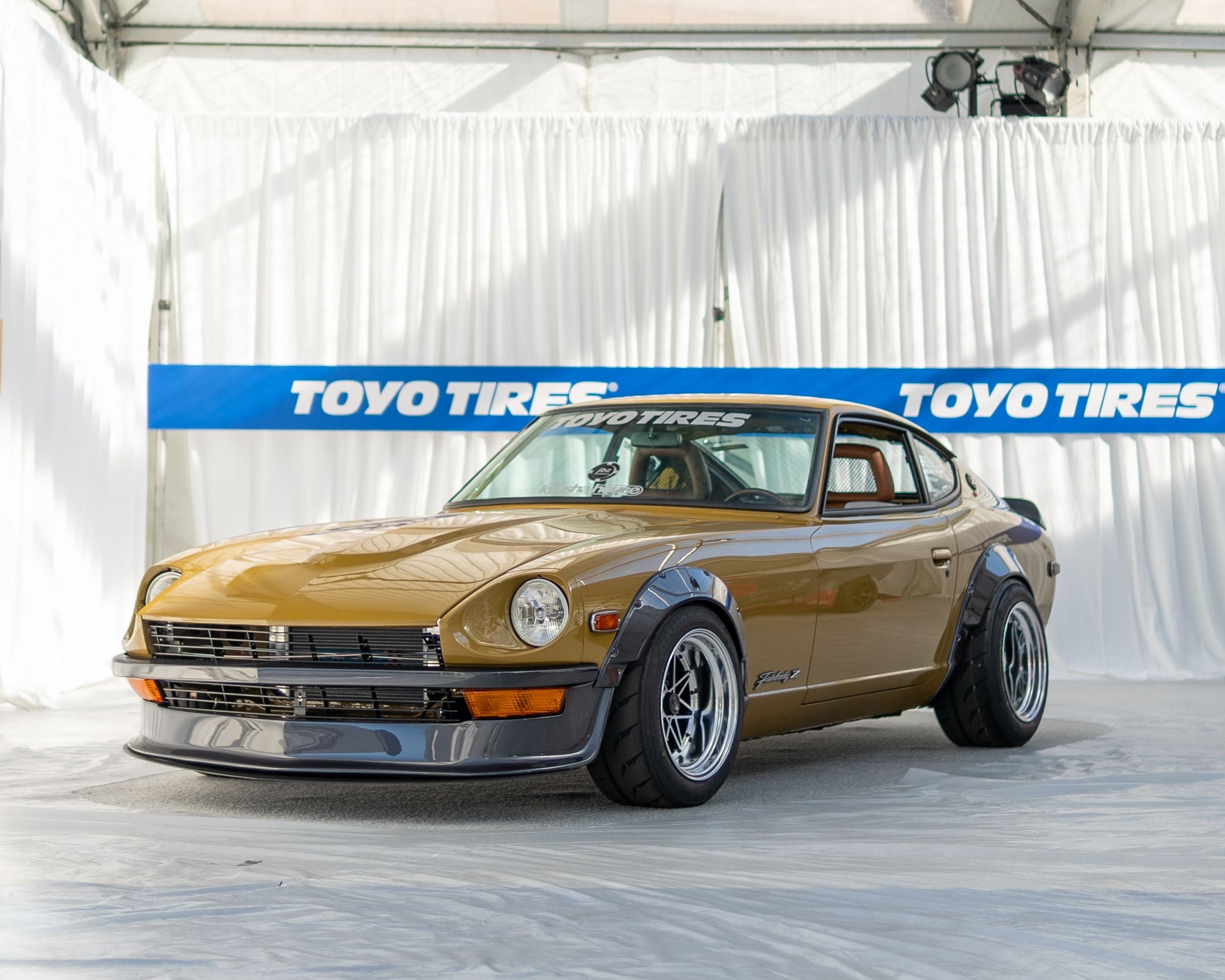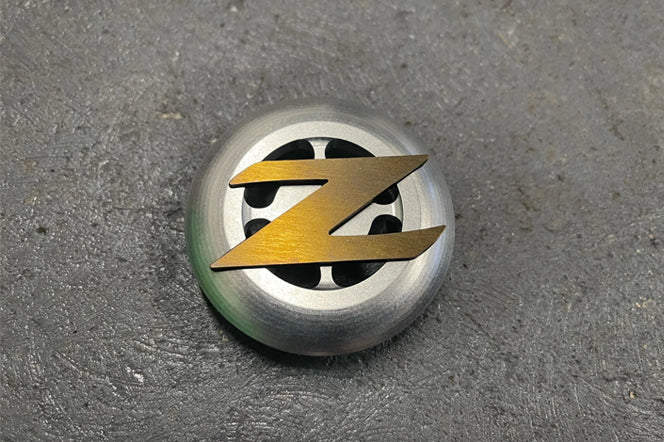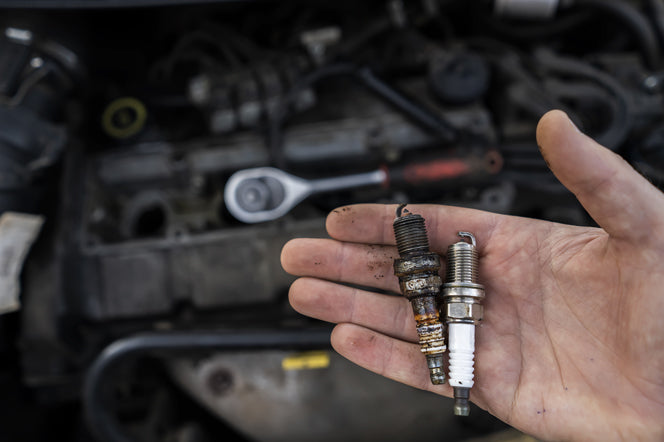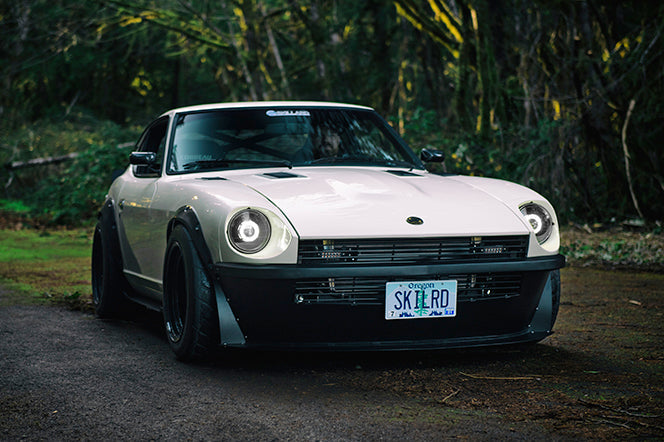Datsun's classic models, like the 240Z, 260Z, and 280Z that were produced between 1970 and 1978, each have special emblems that played an important part in their identity.
These emblems were a small but significant part of what made these vehicles iconic, and there were a handful of little variations that are important to track, especially if you're looking to restore your Z car.
Let's look into each one, starting with the hood emblem!
Exciting News: We just released some brand new emblems for the 240Z, 260Z, and 280Z, as well as for the 280ZX! Precision CNC cut aluminum with a beautiful titanium inlay. Available in raw aluminum and in black powdercoat. Get them while they're hot!
Disclaimer: This article is authored by a member of the Skillard community and reflects their personal views, not necessarily those of Skillard. We welcome your feedback and corrections in the comments to help us continually improve this content.
Table of Contents
The Z Hood Emblems
Datsun models 240Z, 260Z, and 280Z, produced from 1970 to 1978, stand out with their hood emblems. These emblems have the signature chrome "Z" against a black backdrop and are super easy to attach with factory-approved clips thanks to their two-post mounting system.
Throughout their run, these emblems went through minor changes, like switching from plastic to metal, depending on the production year. But no matter the tweaks, the emblem kept its part as an important piece of the Datsun Z series models' styling.

If you have an old or damaged emblem, replacing it is a piece of cake. The market's full of reproduction emblems (which we'll talk about more here in a bit), often made with tough enamel paint that keeps the color looking fresh and lasts a long time.
My advice? Go for the reproduction emblems; they'll make your car look better and help you save some cash. I really think choosing these reproductions is a smart move to keep your classic car looking sharp without breaking the bank.
Did The Z Cars Come With Dash Emblems?
The 240Z model really stood out because it had an emblem on the glove box; the 260Z and 280Z models, on the other hand, went for emblems on their dashboards. Datsun upped the car's cool factor even more by adding emblems to the outside - think rear hatch, fender, and quarter panel. We'll talk about those in a bit.
To get a 260Z dash emblem back to its shiny best, you typically need to polish and re-chrome it. And if you're restoring your car, finding an OEM dash emblem can be a bit of a headache due to its rarity. When you finally get your hands on one, it feels like you've struck gold!

If you're looking to grab or spruce up one of these emblems, it's really important to learn how to keep them in tip-top shape. This involves getting the hang of the right polishing and re-chroming tricks and knowing where to look for reliable sellers or collectors.
Oh, and here's a pro tip: always, always make sure you're going for quality when choosing someone to do the re-chroming. It makes all the difference! And remember, patience is important.
The Fender Emblems
Datsun 240Z models from 1970 to 1973 had "DATSUN" fender emblems placed either on the right or left side. Nissan made these available as original equipment manufacturer (OEM) versions. But, for those really into restoring their cars, several aftermarket options were available, too.
A big change came in 1974 with the Datsun 260Z as emblems were now sitting lower on the front fenders and came in pairs. It was a smart move - 3M material decals offered a cost-saving solution for those watching their wallets.
From 1975 to 1978, the Datsun 280Z introduced "280Z" fender emblems with a flashy orange/gold trim, whether you were after OEM Nissan badges or something from aftermarket suppliers. They measure roughly 9-5/8 inches in width and 1 inch in height.

If you're trying to nail that "Fairlady Z" look, I can't recommend the chrome-scripted "Fairlady Z" emblem enough. It fits all three Z models perfectly and can be slapped on both the fenders and rear spoiler. These have three little pins, so you'll have to drill three small holes for this one if you're trying to install the Fairlazy D emblems on your Datsun.
The Glove Box Emblem
When you look into the various Datsun models, you'll see the differences in glove box emblems across the 240Z, 260Z, and 280Z models. Take the Datsun 240Z, for example; it has chrome lettering on its glove box, which really makes it stand out compared to others.
Switch gears to the 260Z and 280Z models - they mix things up by using emblems with their model numbers in chrome.

Now, the Fairlady Z, predominately produced for the Japanese market, had a chrome-inscribed glove box/dashboard emblem. But don't breeze past the small things between the 260Z and 280Z emblems at first look; they might look like twins, but there are some slight differences to look out for.
It's important to pay attention to these tiny little differences. From the Datsun 240Z's chrome letterings to the model numbers on the 260Z and 280Z, and of course, The Fairlady Z, each model in the lineup has its own variety. It's helpful to know whether you want to restore your car or if you're looking to pull off the Fairlady Z look accurately.
The Metal Roof Pillar Emblems
The Datsun Z series rolled out between 1971 and 1978 - and they really stood out thanks to these unique Z emblems on the metal roof pillars. It was their classic identity marker, something special just for these models.
Do you have these side pillar emblems? They were exactly 2.75 inches in diameter and made from metal, which really added to the cars' authentic, vintage message. These emblems were important in giving the coupe models their specific look, and believe me, it wasn't all just about durability - their heavy metal build really improved the styling of these models. The 3D emblem is a big part of the car's design.
Taking the time to put these emblems back on is an important step in restoring the Z cars to their original luxury, showing off the historical significance and the legacy of the Z-car era. It's a clear example of how even small restoration jobs can make a big difference in a vehicle's authenticity and value. So, if you're someone who's improving the look of your Z models or talking about car restoration, choosing a billet roof pillar emblem from Skillard is the way to go to maintain or bring back the Z cars' classic message.

Want some practical advice? Skillard's emblem scores big on quality and staying true to the original design, which makes it a great pick for your restoration project. This technique is everything if you're looking to improve it's styling and get rid of those old rusty parts, while still honoring the styling of your classic car. These custom-made pieces are an awesome way to do just that.
P.S. You can check out Skillard's stunning billet roof pillar emblems here - I highly recommend checking them out!
What About Hatch and Spoiler Emblems?
The Datsun 240Z gave the brand's image a complete makeover in the 1970s, thanks to its one-of-a-kind plastic hatch emblems and extra body part clips.
By the time the 260Z rolled around, designers had switched things up with metal hatch emblems that had a self-stick back, which made them easier to slap on but kept the cool look of their ancestors.
Then came the 280Z, introducing even more emblem types, like metal "280Z" Fender badges and "Fairlady" emblems that were very easy to clip on, which makes them super user-friendly. The rear emblems had three nubs that would stick into the fender or spoiler.
From 1979 to 1983, the Nissan 280ZX showed the OEM hood badge with the "280ZX" numbering. These badges, often made of tough metal, might have extras like enamel paint to match colors just right, pins for mounting, or sticky tape to make sure they stay put.
Remember, though, not all badges are perfect clones of the originals. Aftermarket ones could vary in size or how you attach them. If you're going for a 1:1 restoration, you might want to spend the big bucks to have your old emblems carefully restored by experts instead of buying reproductions or high-quality third-party options. But if you're building a resto-mod and you're not after museum-grade reproductions, your options are a lot better, and they are more practical and more affordable.

And, of course, the story of the Nissan Fairlady Z Fender / Rear Spoiler Badge is where things get interesting. It's unusual for a 240Z to have a Fairlady badge in the U.S. because the 240Z was marketed under the Datsun brand in the United States, while the Fairlady name was used for the Japanese domestic market (JDM) version.
Still, you'll see these often as fans honor this cool piece of history by wearing Fairlady Z badges of their own! These are placed both on the fender and on the rear spoiler.
Hubcap Emblems on Center Caps
Looking for Datsun Z car hubcaps, especially for popular models like the 240Z, 260Z, and 280Z? Remember, these beauties have specific emblems that indicate their model and production year. They're crafted from steel and have a chrome finish, with a cool dark gray shade for the pieces made from 1971 to 1976. What makes them stand out are their unique plastic emblems and the central clips that hold everything together.
If you're on the hunt for replacements, and if you don't have a model with special hubcaps, you can just get a standard reproduction hubcap emblem center set like these. This baby matches the original factory look with its chrome shine and impressive parts. It even includes tough retainer clips that make installation very easy. It's a perfect match for the late 1971 240Zs all the way up to the 1976 280Zs; it's definitely my favorite for restoration projects.

Got an early 240Z model from 1970 to 1971? Then, you need to check out the 240Z "D" hubcap set. It has this cool "D" emblem and is an incredible reproduction of the factory wheel hubcaps. Also, it comes with all the right plastic emblems and clips for a perfect fit.
In my opinion, if making your vintage Z car look amazing again is your goal, you really can't go wrong with these hubcap sets. And for these early 240Z restorations, the 240Z "D" hubcap set is what I recommend. Picking the right set can make a huge difference in your restoration process, which makes sure everything matches up just as it should and really makes your vehicle stand out!
Japanese Emblem Variants
The 240Z, a hit since its 1970 debut, is a collector's dream. You'll find its "240Z" badge on the sail pillar. In mid-1971, Nissan shook things up - the old badge was swapped out for a vented circle with a "Z," and they ditched the hatch panel vents. If you spot a "Nissan Full Automatic" badge, that's the rare three-speed automatic transmission option; it's quite a find!

In 1974, Nissan rolled out the second-gen 260Z, which was marked with an engine displacement badge. Its stint in the U.S. market was brief, a year, but the rest of the world could grab it until 1978. Because it wasn't around long, it's pretty special to collectors. Figuring out which badges these models sport can get difficult, thanks to different rules and regulations.
By 1975, Nissan was breaking new ground with the 280Z by bringing fuel injection into the picture, saying goodbye to carburetors. It was a big deal, especially since the early models kept the "240Z" chrome badge.
Depending on where you were, the name of these cars changed. In Japan, people called it the Nissan Fairlady Z. And elsewhere, it went by the Datsun, tagged with numeric badges like 240Z, 260Z, and 280Z.
Nissan had this habit of dropping special editions and unique models here and there, which led to even a bigger, complex world of badges. These little mysteries are what make the hunt for collectors super exciting!
Improve Your Z Car One Piece at a Time
Z's holds a special spot for blending old and modern design ideas. When you take on a restoration project, you get to merge classical looks with modern hardware upgrades to improve durability, performance, and styling.
Skillard (that's us!) focuses on Z Cars, creating awesome parts for Datsuns in the USA that boost both the look and performance of Datsun rides. The variety of products has things like bumpers, aluminum door cards, center consoles, and spoilers made just for Datsuns. And of course, check out our awesome billet roof pillar emblems, which shows off our commitment to cool custom options.

Skillard has built a name among Z car fans around the world for turning these old-school cars into modern beauties. We have everything you might need, from big makeovers to small tweaks, which makes sure every Datsun owner gets what they're after. For those ready to talk about or level up their Datsun restoration, we'd love to hear from you to see how we can help you build your dream car.
Looking for solid advice? Hitting up Skillard.com is a smart move to snag the parts you need for your Datsun project; check us out!
Do you have any questions for me? Which emblem(s) are you trying to track down? Did you stick with the rare OEM emblems or use high-quality reproductions? Please share in the comments; I'd love to hear from you!





